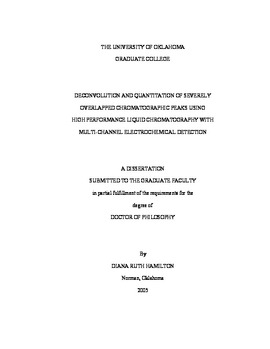| dc.contributor.advisor | Blank, C. L., | en_US |
| dc.contributor.author | Hamilton, Diana Ruth. | en_US |
| dc.date.accessioned | 2013-08-16T12:19:49Z | |
| dc.date.available | 2013-08-16T12:19:49Z | |
| dc.date.issued | 2005 | en_US |
| dc.identifier.uri | https://hdl.handle.net/11244/876 | |
| dc.description.abstract | The chemometric approaches employing two-dimensional time-response information were a bit more reliable in providing accurate outcomes. Each of the PCR, PLS, and SIMPLS approaches accurately predicted with 95% certainty the Epi and Dopa levels in 11 out of 20 cases. | en_US |
| dc.description.abstract | Our hypothesis was that a simple deconvolution in the potential-response domain at a carefully selected time following injection would yield sufficiently accurate determination of the two analytes to 95% confidence levels using the Student's t-test. Our simple potential-response approach was thus compared to standard and commonly employed alternative approaches. | en_US |
| dc.description.abstract | For each method investigated, we determined a mean and standard deviation for the calculated/predicted levels of both Epi and Dopa for each of the five separate mixtures. For the determinations involving only the two standard dimensions of information (i.e., time-response), this procedure was repeated for each of the four electrochemical channels separately. For the chemometric approaches using information from all the dimensions, only one such determination was available for each mixture. Likewise, the simple initially described procedure using potential-response time was only capable of providing a single outcome (mean +/- s.d.) for each of Epi and Dopa for each of the five mixtures. Finally, the individual means were compared to the known standard values in all cases using Student's t-test to determine if the means were the same as the standards at the 95% confidence level. | en_US |
| dc.description.abstract | Finally, the initially proposed single analysis of the data using the potential-response domain and Cramer's Rule for deconvolution proved to be much easier and more accurate than any of the alternatives listed above. In particular, this approach accurately predicted the content of both Epi and Dopa in all of the five mixtures examined at the 95% confidence level. At the same time, the deconvolution using matrix algebra was and is substantially simpler than any of the other alternatives examined. (Abstract shortened by UMI.) | en_US |
| dc.description.abstract | We wanted to create a simple technique that provided a high degree of accuracy in the deconvolution of two chromatographic peaks which were severely overlapped in the usual time-response domain and substantially overlapped in the potential-response domain. The two compounds we selected for investigation which fulfilled these initial criteria were epinephrine (Epi) and L-3,4-dihydroxyphenylalanine (Dopa). | en_US |
| dc.format.extent | xxv, 238 leaves : | en_US |
| dc.subject | Electrochemical sensors. | en_US |
| dc.subject | Liquid chromatography. | en_US |
| dc.subject | Chemistry, Analytical. | en_US |
| dc.title | Deconvolution and quantitation of severely overlapped chromatographic peaks using high performance liquid chromatography with multi-channel electrochemical detection. | en_US |
| dc.type | Thesis | en_US |
| dc.thesis.degree | Ph.D. | en_US |
| dc.thesis.degreeDiscipline | Department of Chemistry and Biochemistry | en_US |
| dc.note | Adviser: C. L. Blank. | en_US |
| dc.note | Source: Dissertation Abstracts International, Volume: 66-02, Section: B, page: 0863. | en_US |
| ou.identifier | (UMI)AAI3164566 | en_US |
| ou.group | College of Arts and Sciences::Department of Chemistry and Biochemistry | |
